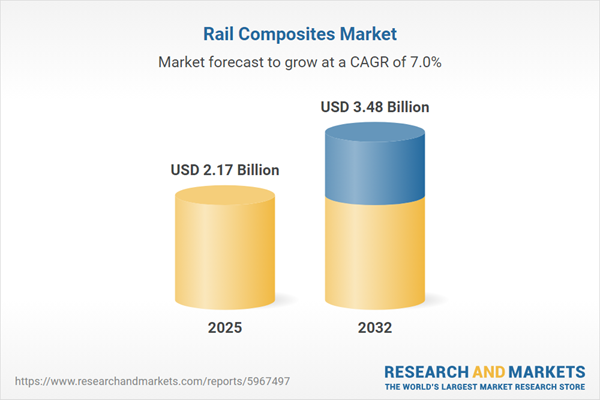Speak directly to the analyst to clarify any post sales queries you may have.
Rail composites are fundamentally transforming rail transport, offering senior industry leaders advanced solutions for improving design efficiency, safety, and operational costs. As demand grows for lighter, more durable, and sustainable materials, the rail composites market stands as a critical focus for strategic procurement and innovation.
Market Snapshot: Rail Composites Market Performance and Outlook
The rail composites market grew from USD 2.03 billion in 2024 to USD 2.17 billion in 2025, marking steady expansion. With a projected CAGR of 6.95%, the market is expected to reach USD 3.48 billion by 2032, signaling sustained growth amid evolving industry demands.
Scope & Segmentation
- Application Areas: Ancillary components such as electrical assemblies and window frames; interior elements including flooring, paneling, and seating; structural systems, namely body shells, roofs, and underframes.
- Material Types: Aramid fibers (Kevlar, Twaron), carbon fibers (high modulus, standard modulus), and glass fibers (E glass, S glass) are at the forefront.
- End Uses: Freight trains, metro/light rail, and passenger train categories with commuter, high-speed, and intercity specifications.
- Manufacturing Processes: Industry uses compression molding, filament winding, pultrusion, and resin transfer molding to address volume, precision, and complexity requirements.
- Geographical Coverage: Americas (United States, Canada, Mexico, Brazil, Argentina, Chile, Colombia, Peru), Europe, Middle East & Africa (United Kingdom, Germany, France, Russia, Italy, Spain, Netherlands, Sweden, Poland, Switzerland, United Arab Emirates, Saudi Arabia, Qatar, Turkey, Israel, South Africa, Nigeria, Egypt, Kenya), and Asia-Pacific (China, India, Japan, Australia, South Korea, Indonesia, Thailand, Malaysia, Singapore, Taiwan).
- Company Profiles: In-depth analysis of Toray Industries, Inc.; Teijin Limited; Hexcel Corporation; Solvay SA; SGL Carbon SE; Mitsubishi Chemical Corporation; Gurit Holding AG; Evonik Industries AG; Owens Corning; and 3M Company.
Key Takeaways for Senior Decision-Makers
- Emerging innovations in composite materials are enabling manufacturers to achieve better durability, thermal management, and fire safety to address evolving safety and compliance benchmarks.
- Digital integration, including the use of sensor-embedded materials and digital twins, is streamlining predictive maintenance and facilitating proactive asset management for operators.
- Bio-based resins and recyclable thermoplastics are advancing from pilot concepts to mainstream options, aligning with global sustainability and environmental regulations.
- Regional initiatives are driving tailored adoption strategies, with Europe focusing on circular economy objectives and Asia-Pacific leading in high-performance composite integration for high-speed transit.
- Strategic alliances, vertical integration, and investments in proprietary technologies are facilitating rapid material qualification and operational synergies across the supply chain.
Tariff Impact and Supply Chain Realignment
Tariffs imposed in 2025 forced a significant restructuring of sourcing strategies for rail composite materials. Many manufacturers are now prioritizing regional suppliers and localization to reduce exposure to shipping costs and import duties. This move has led to deeper collaborations within local markets and prompted a reassessment of total lifecycle expenses, favoring solutions with long-term maintenance and fuel efficiency benefits over upfront material costs. Resilient supply chain frameworks and cost-transparency initiatives have become vital for sustained competitiveness.
Methodology & Data Sources
This report utilizes a blend of secondary research—including technical literature and regulatory documentation—as well as primary insights from interviews with executives in resin and fiber production, rail OEMs, and transportation authorities. Comprehensive quantitative validation was achieved using proprietary databases and scenario workshops, ensuring findings reflect both industry consensus and objective data.
Why This Report Matters to Senior Leaders
- Supports informed procurement, design, and investment decisions with segmented market insights tailored to operational realities and regional differences.
- Highlights pathways to supply chain resilience and compliance with sustainability mandates, facilitating long-term risk mitigation.
- Delivers actionable strategies for technology adoption, collaboration, and entry into high-growth geographic markets.
Conclusion
The rail composites market continues to evolve, shaped by regulatory pressures, emerging technologies, and shifting global supply chains. This analysis provides a robust foundation for senior leaders to align strategic and operational objectives in a complex, dynamic industry landscape.
Additional Product Information:
- Purchase of this report includes 1 year online access with quarterly updates.
- This report can be updated on request. Please contact our Customer Experience team using the Ask a Question widget on our website.
Table of Contents
3. Executive Summary
4. Market Overview
7. Cumulative Impact of Artificial Intelligence 2025
Companies Mentioned
The companies profiled in this Rail Composites market report include:- Toray Industries, Inc.
- Teijin Limited
- Hexcel Corporation
- Solvay SA
- SGL Carbon SE
- Mitsubishi Chemical Corporation
- Gurit Holding AG
- Evonik Industries AG
- Owens Corning
- 3M Company
Table Information
| Report Attribute | Details |
|---|---|
| No. of Pages | 189 |
| Published | October 2025 |
| Forecast Period | 2025 - 2032 |
| Estimated Market Value ( USD | $ 2.17 Billion |
| Forecasted Market Value ( USD | $ 3.48 Billion |
| Compound Annual Growth Rate | 6.9% |
| Regions Covered | Global |
| No. of Companies Mentioned | 11 |









